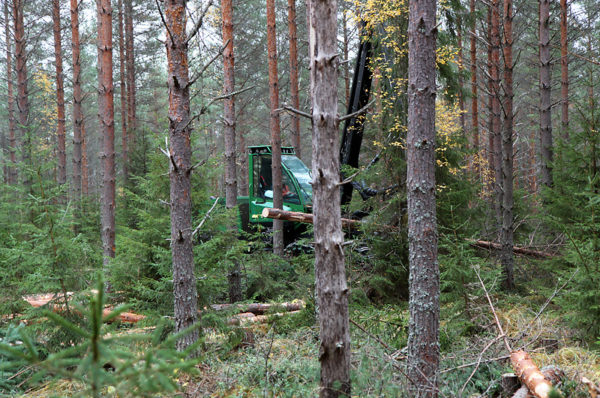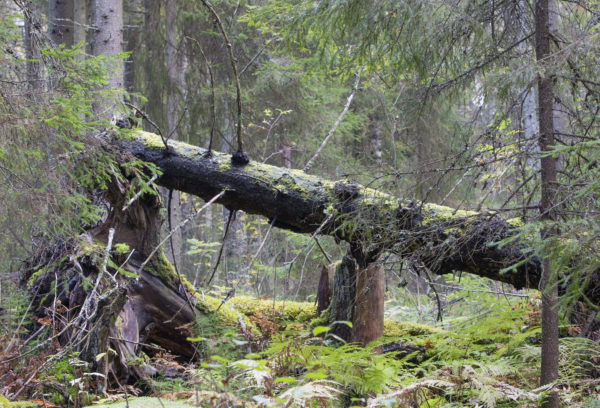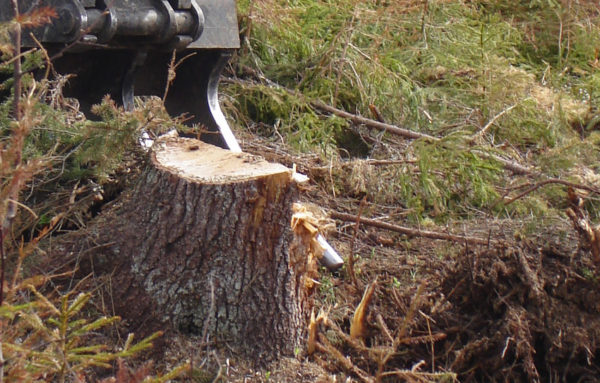EU Commission proposes to make continuous-cover siviculture dominant method – researcher sees this as return to foraging economy

Forest.fi looks at recent research to compare continuous-cover and periodic silviculture in terms of their impact on the climate and the ecology and economics of forestry. The main conclusion remains the same: there is no either-or answer to which method is better; instead, everything depends on site characteristics and the forest owner’s needs.
’If the European Commission’s plan to move to continuous-cover silviculture in all commercial forests becomes a reality, it will bring great challenges to timber procurement, assuming that the total felling volumes are to remain on the present level,’ says Antti Asikainen, Executive Vice President for Research at Natural Resources Institute Finland.
To solve climate issues, demands are voiced that forestry must increase carbon sinks by decreasing felling volumes. Asikainen points out that the financial significance of forests is increasingly important now that nations have run up substantial debts.
’The added value for the national economy of each cubic metre of timber is about EUR 150. If we fail to get that sum from the forest, what is the alternative,’ asks Asikainen.
On the other hand, the Commission also demands that wood be used, and wood is available in the forests of Europe.

If, however, timber was only harvested with continuous-cover methods, as is demanded by the Commission, Asikainen sees that as giving up the cultivation-based forestry adopted in the 1950s.
If, at the same time, the use of timber remained on the present level, the area under felling would have to be increased, because only some of the trees growing on a felling site would be harvested.
’The risk of damaging live trees during harvesting would increase, and it would be more challenging to manage the harvesting profitably. It would mean a return to a foraging economy,’ says Asikainen.
Asikainen was one of the speakers at a seminar on continuous-cover silviculture, arranged by Natural Resources Institute Finland and Metsähallitus in April.
No method is good if used exclusively
If continuous-cover silviculture was the only method, it would not necessarily be good for nature either. According to research, increasing its use from the present extent would improve biodiversity, but making it compulsory would, for the future of forest species, be like taking six of one and half a dozen of the other.
It is only about ten years since researchers have been able to monitor the development of biodiversity in continuous-cover forests.
’We’ve only just started,’ said Research Professor Matti Koivula, speaking at the seminar.
Koivula’s presentation was based on 55 publications, most of which deal with selection fellings. The situation on small-diameter felling sites has been studied in over 20 publications. Development in the condition of species was compared with clear-felling forestry and old-growth forests.

In continuous-cover forests the volume of growing stock is subject to less variation than in forests managed by periodic clear fellings. Continuous-cover forests will not have an old-growth stage, clearly discernible seedling or sapling stands or areas of open forest with plenty of sunlight and heat.
Koivula does not consider this a problem at the moment, since most forests are managed by periodic-cover methods.
’In the long run, species favouring open forests may have problems if continuous cover is the only method,’ Koivula said.
Regardless of method, presence of deadwood is not automatic
Continuous cover is advantageous to species that demand shade.
’A good example is bilberry, which is an important source of food and forms the basis of many food chains in the forest,’ said Koivula.
Similarly, lichens living on tree trunks and branches may benefit from continuous cover. They grow on large trees, which are always found in continuous-cover forests.
’But will the lichens survive if selection and small-scale fellings are repeated for several decades? That’s something we have no data on,’ said Koivula.
On the other hand, several species benefit from clear fellings. While no threatened species are dependent on clear fellings, some of them do favour an open environment. Some endangered species living in open environments can also find a home on clear-felling sites.

No silvicultural method, however, will automatically lead to the creation of habitats important for threatened species, such as deadwood or trees of sufficient stoutness. These habitats must be created by means of nature management. There are hundreds of threatened species that depend on stout living or dead wood.
Quality variation in continuous-cover spruce
As regards the yield from spruce, continuous cover is successful as long as certain conditions are met. One of the main ones is the emergence of seedlings. The profitability of continuous-cover forestry is based on not having to plant or sow new trees; instead, seedlings should spring up naturally.
Senior Scientist Sauli Valkonen said that ’you can make it work’. He then went on to say that what will work and why is another thing.
’There’ll be plenty of seedlings and they’ll grow into trees. But they’ll grow incredibly slowly. A seedling may take 50 years to reach the height of 130 centimetres,’ Valkonen said.
This is a new and important finding: even trees that have just bided their time for 30 years will start growing well.
’On the other hand, these small spruces will perk up and begin to grow well as soon as they get enough light and space. This is a new and important finding: even trees that have just bided their time for 30 years will start growing well,’ said Valkonen and continued that forests should not be allowed to grow either too densely or too sparsely.
One of the requirements is a mix of tree species. Achieving that means that small clearings must be made in the forest. ’Just carrying out selection felling leads to spruce overtaking other species,’ said Valkonen.
The first sample plots for continuous-cover spruce cultivation were established as early as the 1980s. They have shown that a good annual increment may continue for 30 years or more. On average, though, the yield will be 15–30 percent less than with clear-felling forestry.
Spruce logs from continuous-cover forests have an extra-dense core, created during the time when the sapling grew slowly in a dense stand. This core is surrounded by wood of normal density, created after the neighbouring trees have been thinned out.
According to Valkonen, this dense core does not affect the quality of spruce for pulp production, but it does cause variation in the quality of logs sold to sawmills and the timber grades made of them. This increases the need for sorting.
Valkonen said it is difficult to estimate the significance of this.
Less research on pine than on spruce
Continuous-cover pine stands are much less researched than spruce stands, though some sample plots were set up in the early 1980s on xeric (dry) and sub-xeric heaths.
’Regeneration has succeeded well without soil manipulation, though manipulation does improve natural regeneration. However, the seedlings spring up in clusters, which means there will be open spaces and growth will be weaker,’ said Professor Pasi Rautio from Natural Resources Institute Finland.

Another problem is that between the open spaces there have been practically no seedlings.
Opening up pine stands has also been tested. The result was that seedlings sprang up poorly, but a light soil manipulation increased this and improved growth.
There are currently about one thousand sample plots for pine. They have shown that in opening up, over half of the trees must be removed for a successful spontaneous regeneration.
The trees have been found to grow slowly, reaching a height of 50 centimetres in 15 years. These experiments were carried out in the north of Finland, but Rautio said the conditions in the south are not significantly different, except for the amount of light.
Continuous cover is advantageous on peatlands
Expectations are particularly high regarding continuous-cover forestry on peatlands. This is because of the fluctuation of groundwater tables in forests under periodic-cover forestry.
Trees remove water from the soil through evaporation. In a clear felling on a moist peatland site, evaporation drops as the trees are removed and the groundwater table will begin to rise. This will increase methane emissions and the leaching of phosphorus, nitrogen and organic carbon into waterways.
Using continuous cover on peatlands, the groundwater table could be kept stable, no higher than at a depth of 30–40 centimetres.
Then again, when trees grow on peatland, the groundwater table will drop, and carbon begins to be freed from the soil into the atmosphere.
Under continuous cover the trees and their evaporation activity are maintained , reducing the fluctuation of groundwater tables and also the emissions.
’Using continuous cover on peatlands, the groundwater table could be kept stable, no higher than at a depth of 30–40 centimetres,’ said Markku Saarinen, Senior Scientist at Natural Resources Institute Finland.
Here, too, the fact that trees grow in clusters is a problem. Between clusters the groundwater table may rise.
’In the case of small-diameter fellings, the maximum diameter of the clearing should be 20 metres. Otherwise the groundwater will rise too high in the middle of the clearing,’ said Saarinen.
Smaller risk of damage with continuous cover – except for root rot
So far, little is known about the risk of forest damage when using continuous cover.
’The risk of damage is, however, thought to be smaller with continuous-cover forestry than with periodic forestry. An important exception is root rot,’ said Research Professor Jarkko Hantula from Natural Resource Institute Finland.
According to Hantula, the risk of fire, storm, snow and wind damage is likely to be smaller with continuous-cover forestry.
The cost to forestry of root rot (Heterobasidion) is about EUR 50 million per year. The damage to pine costs about EUR 5–10 million, with spruce being the main sufferer.
In pine stands root rot is practically impossible to eradicate. In spruce stands, the only solution is clear-cutting; in other words, giving up the continuous-cover method.
In addition, after clear-cutting the site must be replanted with broadleaves, and spruce must be kept off the site for at least 30 years.
Damage during felling also poses a risk, since damaged trees can be infected by airborne root rot.
Forest owner decides
The conclusion from the many expert presentations during the seminar was that there is no universally valid answer to the question about which forestry method is the best. All depends on the growing conditions of the site, the characteristics of the growing stock and the needs of the forest owner.
Kalle Vanhatalo from the forest advisory and consulting services company Tapio continued the list by citing the forest owner’s ability to deal with uncertainty.
’The risks related to silvicultural methods vary, because the probability of meeting the various objectives also varies,’ Vanhatalo said.
It’s pointless to strive for, say, landscape-related benefits if the owner doesn’t see any value in them.
Vanhatalo’s position is Coordinator of Best Forestry Management Practices. His definition of best practices sets them apart from other guidance and instructions on forestry: ’Best practices are recommendations that show the forest owners how their ecological and financial objectives can be achieved.’
’That’s not something you’ll find in forest certification standards or legislation,’ said Vanhatalo.
Vanhatalo went on to say that all the objectives of the forest owner must be met, for otherwise the solution is no good.
’Also, all the advantages will only be advantages if the forest owner views them as such. It’s pointless to strive for, say, landscape-related benefits if the owner doesn’t see any value in them,’ said Vanhatalo.
Translation: Heli Mäntyranta
Luonnonvarakeskuksen synteesiraportti jatkuvasta kasvatuksesta (only in Finnish)
Luonnonvarakeskuksen tiedote synteesiraportista (only in Finnish)